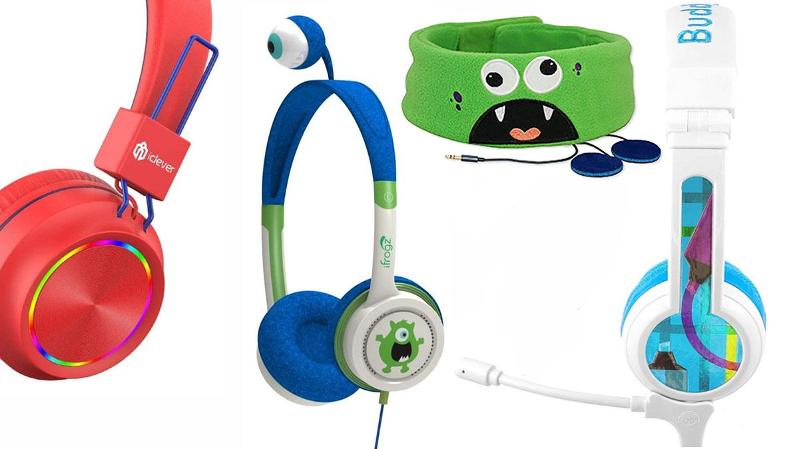Choosing the best headphones for your children is important because using the wrong ones could cause life-long damage to their hearing.
Headphones for kids are essential tech kit for parents as (1) none of us want to hear Spongebob for more than ten minutes or be subjected to either blam-blam action gaming or the high-pitched whine of Alvin the Chipmunk, and (2) maybe we can listen to something else while the kids are amused on the computer, tablet, phone or TV.
With remote-learning and home-schooling, a decent set of kids’ headphones is even more important these days.
Another good reason for investing in child-specific headphones is for use on long-haul flights. Getting your child to watch a couple of movies during a boring flight is a big bonus for parents. The trouble is that airline-supplied headphones aren’t designed for small heads and so often slip off. These kids headphones shouldn’t do that.
But putting adult headphones on to your children’s head could endanger their hearing. See more on child headphone use below.
You should also consider fit, comfort and design, but also limit the amount of time a child uses headphones whatever the volume.
Read our full kids headphones reviews below. We tested each model for sound quality, volume limitation, comfort and safety.
The maximum noise level recommended by many auditory health organisations is 85 decibels (dB), and to get our recommendation a child’s set of headphones shouldn’t, we believe, go any louder than that – Maxell and Sony sell kids sets at 90dB. Adult headphones usually peak at 115 decibels (equivalent to a loud train), and experts warn that you could experience severe hearing loss after just 15 minutes of listening at that level every day.
There’s a pair of headphones reviewed below that are made specifically for gamers – and this is vitally important as players can be listening to loud explosions and other ear killers for hours on end.
Are any headphones safe for kids?
Experts also suggest that the time spent listening to headphones should be limited to two hours a day (for children and adults), even if the volume is limited at 85dB.
Limiting the volume on headphones you give to your kids is obviously a wise decision if you want to help protect their hearing, but some experts warn against children using any type of headphones.
While the World Health Organization (WHO) and EU state that 85dB is an effective safety limit, the US Environmental Protection Agency and US Centers for Disease Control and Prevention recommends 70dB as the average daily noise exposure level. That 85dB level is derived from occupational studies of noise exposure and hearing loss for adults, not children.
The trouble is that 70dB is very quiet and will likely not drown out ambient noise, so 85dB becomes the norm despite it being potentially damaging to a young person’s hearing.
Children’s ears are more sensitive to noise damage, due to growth and development of nerve fibres and other cells. Also because of their smaller external auditory canals, the eardrum is closer to the sound source.
Daniel Fink MD, who serves on the Board of the American Tinnitus Association, warns: “An industrial-strength occupational noise exposure level (85dB) meant for truck drivers, factory workers and miners is far too loud for a child’s delicate ears, which have to last her or him a lifetime.”
A sensible compromise would be to invest in a decent set of headphones that limits volume, but also limit the length of time children wear them.
Find out how we test audio.
Best headphones for kids
With those warnings taken on board, we’ve rounded up the best kids headphones (and some that don’t make the grade but are listed on Amazon and other retailers as suitable for kids) and tested them on a bunch of children and some discerning parents.
What we are looking for in a great set of kids headphones is an effective volume limiter to protect those sensitive ears, a good, comfortable fit for smaller heads, minimum noise leakage (the sound that others can hear outside of the headphones), and some kid-friendly fun in the design.
Don’t buy earbuds or any in-ear model for children – as the closer the sound source is to the delicate working of the inner ear, the more damage loud sound can do.
And just because your chosen headphones are volume limited, don’t let children wear them for hours on end. Even at 85dB prolonged headphone usage is not recommended.
Always remember that corded headphones pose a strangulation risk to young children, and as such most warn against under-threes wearing them unsupervised. One solution is wireless headphones, although these cost more and require regular battery charging. If you can afford it, Bluetooth kids headphones are well worth consideration.
Many smartphones and tablets let you monitor your headphone volume. iPhones and iPads do this in the Health app, under Hearing and Headphone Audio Levels. Some Android phones let you set a volume limit, too. And the Google Play store has apps that limit volume, such as Volume Limiter.
Best headphones for kids 2020
iClever BTH03 – Best value kids wireless headphones
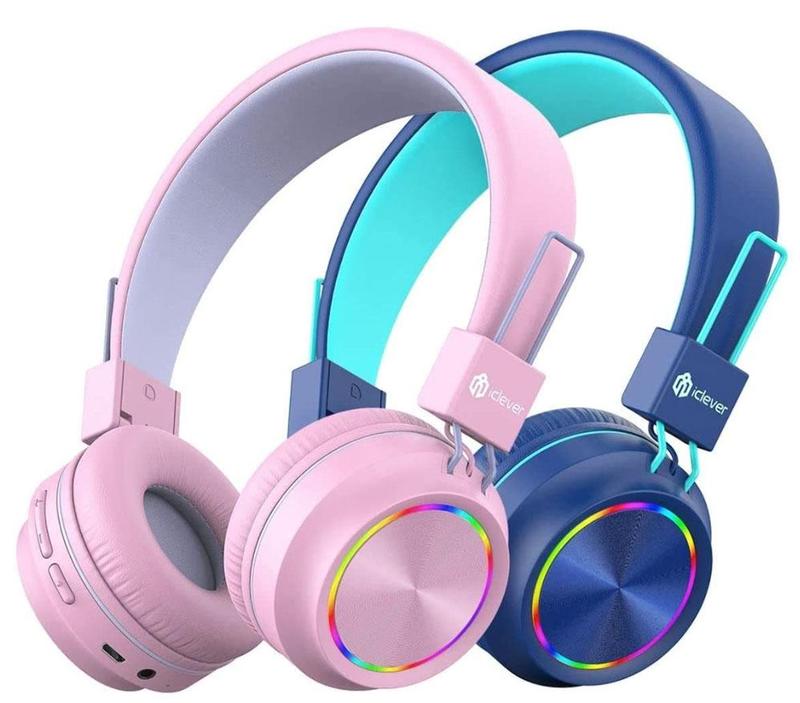
The iClever BTH03 Kids Wireless Headphones are great value for money, offer a decent battery life for Bluetooth headphones, are light and comfortable with adjustable headband, and come with multicoloured LEDs on the outside.
Sound quality is great (with a tendency to bassiness) for a pair of headphones in this price range, and the volume is limited to 85dB, although this still sounded quite loud in our tests.
We’ve tested quieter, but these often raised complaints from our helpful child testers, so if you can trust your child not to wear these at full volume for hours on end, you should be ok.
Pairing via Bluetooth 5.0 was easy after fully charging the headphones, and they also come with a detachable cable for those times when you’ve forgotten to charge the headphones up beforehand.
There are basic controls on the earpiece: play, pause, answer and end phone calls
If you want to run the battery down a little quicker or just look the coolest kid at the party, then turn on the multicoloured LEDs on each earpiece.
Conveniently, they fold into a small and robust shape, although exactly how robust they are depends on your child, of course!
ONANOFF BuddyPhones School+ – Best kids headphones with boom mic
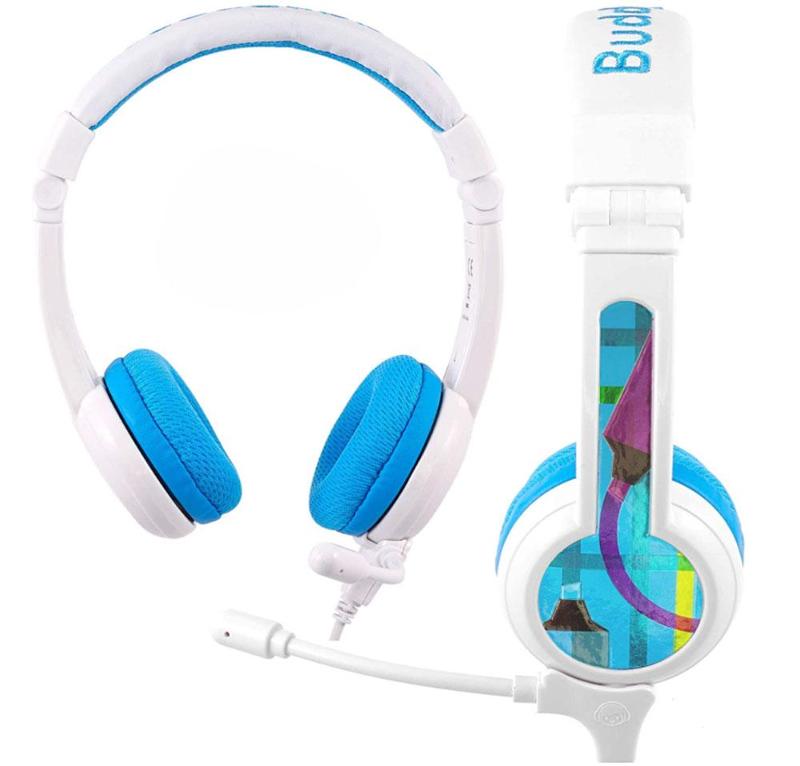
These excellent kids headphones are built for home-schooling and remote learning, with a quality boom microphone built into the BuddyJackCable, which also allows another headset to be added to the one source.
It also comes with a mic-less cable if you don’t need the microphone.
Audio quality is great for both wearer and listener. The kid-safe volume-limiting (85dB) works a treat, and isn’t either too loud or too quiet, and it features effective passive noise cancellation.
The over-ear headphones are comfortable and adjustable, and come with a bunch of stickers for customisation. There are colour options from Blue, Pink and Green to Yellow, and a carry bag is included.
The headphones aren’t wireless, so you may need an adapter for modern phones or tablets that don’t come with a headphone jack.
Puro Sound Labs PuroQuiet – Best noise-cancelling kids headphones
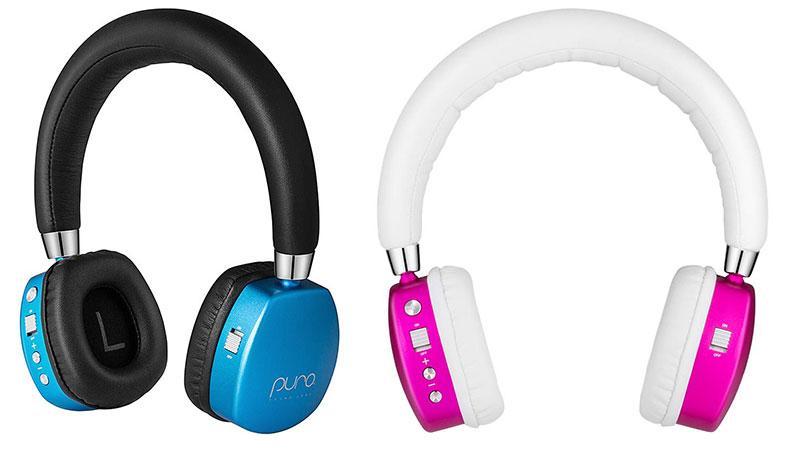
Also from Puro are the PuroQuiet kids headphones, which are a class apart from most of the cheaper headphones reviewed here.
They are not just volume-limited (to the standard 85dB) but offer active noise-cancelling (up to 22 dB). Just flick the ANC switch on the right ear cup, and background noise is filtered out, and the audio quality improves significantly.
There are volume buttons on the left cup, with the power on/off switch. The volume did sound a little higher than some of the other headphones – not excessively so, but still noticeable. If you can trust your child not to keep pushing volume up, then you shouldn’t have any problems.
Using Bluetooth, the PuroQuiet do away with a cable, which also reduces risks of injury by entanglement. The wireless pairing was simple. In case you forget to charge the headphones (via the included microUSB cable), there’s a detachable cable included, as well as a nice carry case to protect them when not in use.
Available in rather gender-based Blue and Pink, PuroQuiet is at the higher end of the price scale but warranted for the build quality, which is excellent. These headphones seem built to last compared to some of the cheaper plastic sets. If you can afford the extra you get your money’s worth.
Puro Sound BT2200 – Best non-kiddy kids headphones
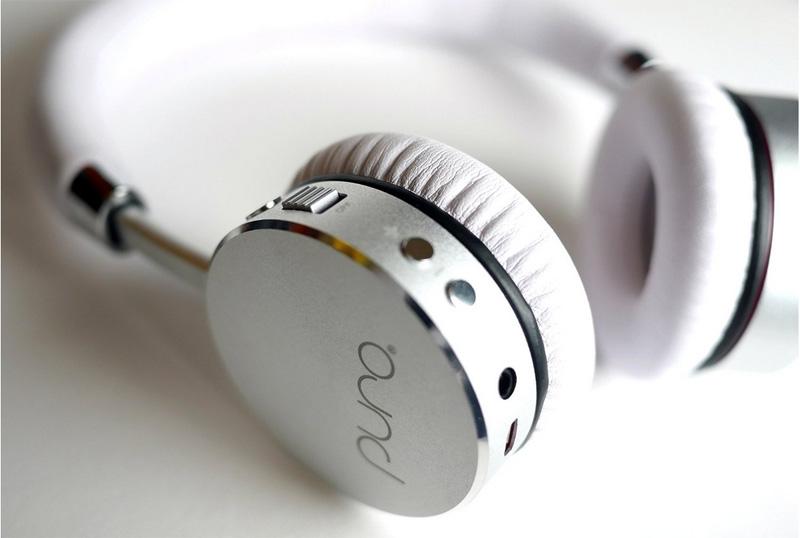
While many kids headphones are quite plastic-y the Puro Sound Labs BT2200 headphones look more like a high-end adult audio product, and the cost reflects this, too.
Buying the Puro BT 2200 is a big step up from most of the cheaper headphones listed here. However, there’s a special deal on the BT2200 until January 1, 2020; see pricing above.
You don’t get just a more stylish, less kiddy look. The audio quality of these headphones is also noticeably higher, even using Bluetooth.
That’s right, the Puro BT2200 are wireless, too – which is great if you’ve had too many cables damaged by a child yanking them around, or you’re worried about the cable wrapping around a small neck.
Volume is limited to 85dBA, and we found that this was more than sufficient. DSP-based volume-limiting means that the electronics actively monitor volume levels, with the limiter kicking in only when the sound reaches 85dBA.
These headphones go further than just limiting the volume. They also block background noise, attenuating 82 percent of sound at 1kHz. This reduces the need to turn them up to a dangerous level even when in a noisy environment such as an aeroplane.
The comfortable ear cushions also help block outside noise. The ear cups and headband are made of durable aluminium, while the ear cushion and band cover are leather. There are available in Purple, Blue, Pink and Grey.
Using Bluetooth means that these headphones need to be charged, and the “up to 18 hours” of battery life should be enough for most journeys. If the battery does run out there’s a detachable cable included. Volume controls are situated on the left earpiece.
The Puro Sound Labs BT2200 headphones certainly cost more than most kids headphones but the higher audio quality, build and wireless function make them serious contenders as our favourites.
PuroBasics – Best wired kids headphones
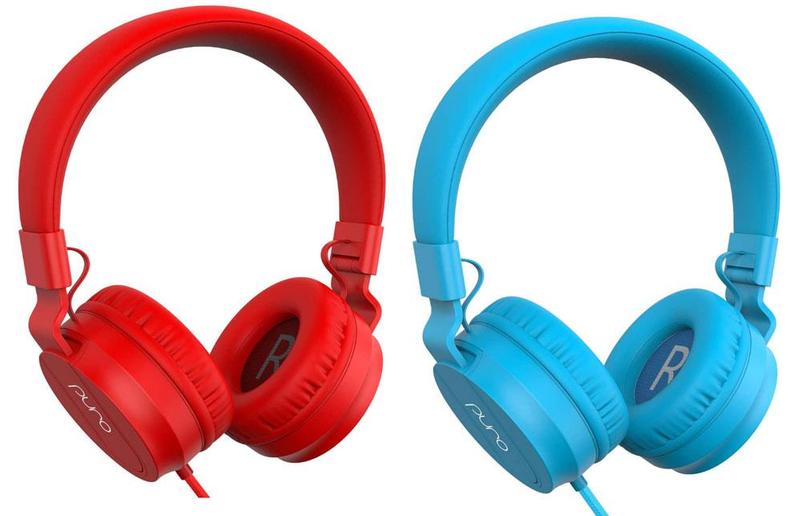
Also from Puro, which has several different models of kids headphones, are the PuroBasic – which we have to presume is the entry-level for this quality brand.
The sound is good for an inexpensive pair of headphones. Volume is limited – not so much that you can’t hear much (a common complaint) but enough that I’d count these as fairly loud.
They are comfortable and adjustable, with the soft ear cups made from vegan leather in a lightweight, flexible plastic frame.
PuroBasic are wired headphones (with 3.5mm jack), so you’ll need an adapter if you want to use these with a phone or tablet without a headphone jack.
They are available in Red, Blue, Pink and Green.
imoo Ear-care Headset – Best off-ear headset
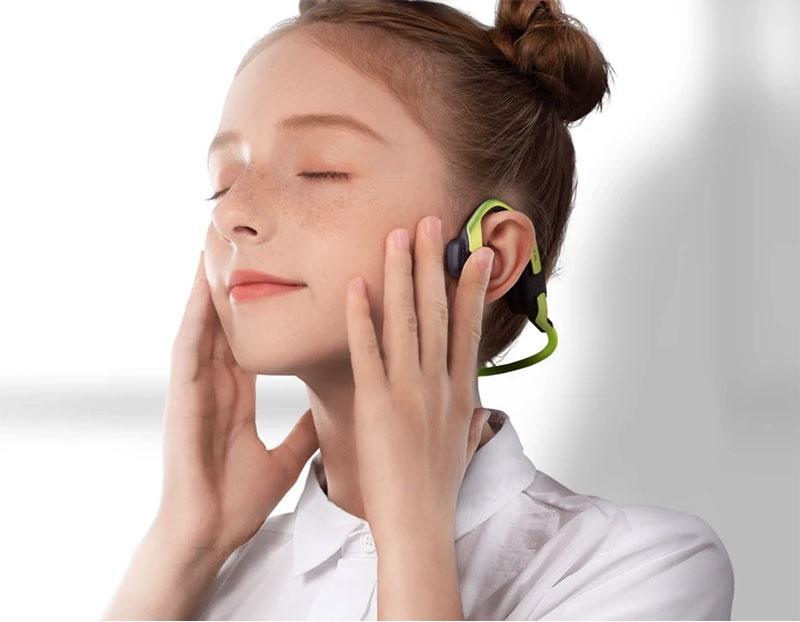
If you worry about sticking earbuds into a child’s ears or covering them with foam and so blocking outside noise, the Bluetooth imoo Ear-care kids wireless headphones cleverly keep the speaker away from the eardrum.
The speakers instead sit just in front of the ear, beaming the sound into the ear. They therefore allow outside sound (which might well be the parent’s voice or traffic noise) to be heard. Noise leakage is surprisingly low.
Audio quality is pretty good, maybe lacking some bass but nice and clear.
The Imoo headset is lightweight (30g) and is designed for children aged 4-15 years old.
Volume is limited to 85dB, although they seemed a little louder than some. We weren’t worried about this as much as with other headphones as the sound is not right into the child’s ear.
Snuggly Rascals – Best alternative kids headphones
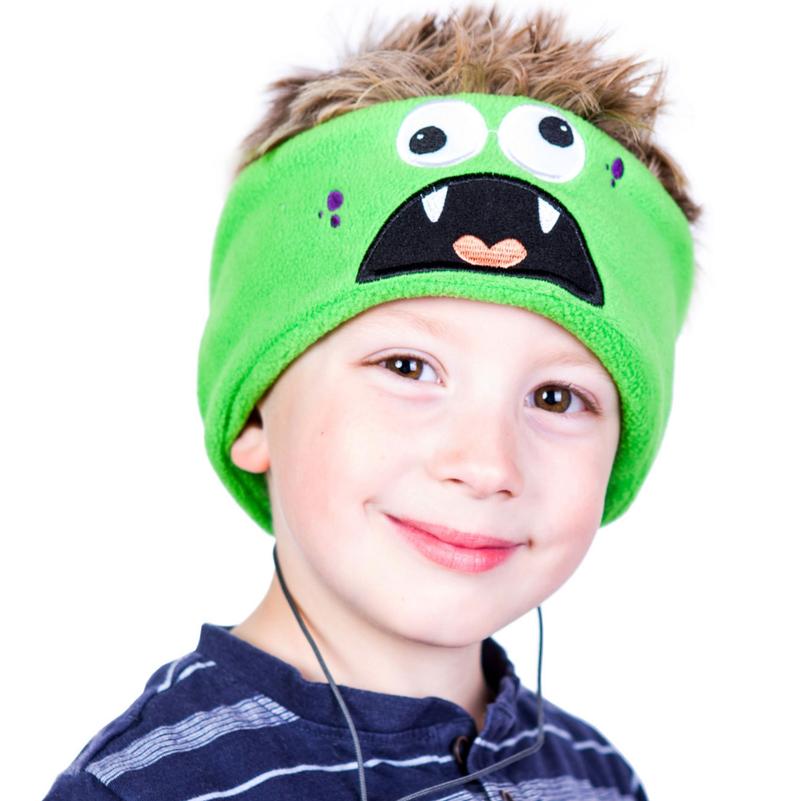
We like a product that tries something different, and that’s the case with Snuggly Rascals over-ear children headphones. These wrap around the child’s head and are adjustable with Velcro. It will even keep little ones’ ears warm, and they won’t fall off or break as easily as normal headphones.
They’re super comfortable, and you can’t feel the flat speakers through the material.
The sound quality was good, even through the fleece and a child’s long hair. Although specified as a maximum of 85 decibels it’s at the quieter end of the audio…
